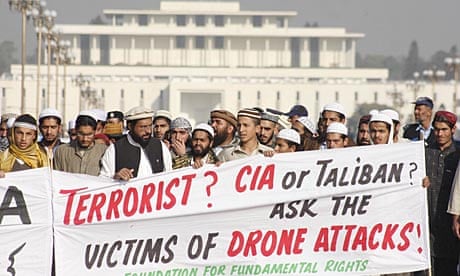Targeting individuals who pose an imminent threat to the US is a lawful exercise of self-defense. But the current US targeted killing program – using unmanned aerial vehicles (UAVs, or drones) to strike terrorist operatives wherever we find them – raises a big red flag.
This is not simply because the policy uses UAVs – remotely piloted combat aircraft are not inherently unlawful. Nor simply because of civilian deaths: although horrible and tragic, not all civilian deaths from military operations are unlawful. Nor simply because most strikes are in countries with whom we are not at war: states have a right to act in self-defense to protect their national security, even outside of armed conflict. Nor is it simply because intelligence personnel carry out many of the strikes: nothing in international law mandates that only military personnel can engage in combat.
Although important, these critiques do not strike at the heart of the issue. It is the characterization of who we target and when – and how that determination is made – that raises serious questions of law and morality. In a nutshell: are we killing the right people?
Effective counterterrorism requires the nation state to apply self-imposed restraint. Otherwise, violations of international law and morality are inevitable. How counterterrorism is carried out will determine its legality under governing international instruments.
Among the many important international law principles applicable to targeted killing, the obligation of distinction sits at the pinnacle. The notion of counterterrorism as self-defense against imminent threats of harm means that the state must know, in a detailed manner, who poses such a threat, in what circumstances, and how and when such persons can be targeted. This information and analysis lies at the heart of the legitimate target determination.
Decision-makers must then conduct the necessary proportionality analysis: will civilians be harmed and if so, how many? To minimize the number of innocent civilians killed during conflict, the attacking party must refrain from any attacks where the expected civilian casualties will be excessive in relation to the anticipated military gain.
Recent debates have highlighted questions regarding the justness of the US use of targeted strikes as a method of warfare, focusing on the "unmanned" nature of the strikes. But just war concerns do not get to the heart of the issue. Similarly, there is little doubt that UAVs offer extraordinary accuracy and precision in targeting identified targets. Rather, the central issue is the accuracy in identifying those targets in the first place, and identifying those who will also suffer as a result of the attack if launched.
Ultimately, the lawfulness of targeted killing depends, in large part, on the efficacy of the internal administrative measures adopted to identify targets and minimize civilian casualties. Only when those procedures are effective and discriminating will targeted killing be both legal and moral.
Why? Because targeted killing is not about encountering a division of the enemy's forces on the battlefield and stopping it from advancing across the front towards your borders or essential infrastructure. That is the stuff of traditional conflict, of trench warfare and tank warfare and state versus state conflict. Instead, targeted killing rests on the specific identification of individuals who pose an imminent threat to the state's national security and are therefore legitimate targets within the framework of lawful self-defense. The state thus needs a method and a process for figuring out who poses a threat, why they pose a threat, and how that threat can be deterred or eliminated.
The current US approach, however, is far too suggestive of "guilt by association" – targeting individuals whose involvement in terrorism is broadly defined, potentially without reliance on criteria, standards and limits. In a recent speech, President Obama's counterterrorism adviser, John Brennan, stated:
"We are finding increasing recognition in the international community that a more flexible understanding of "imminence" may be appropriate when dealing with terrorist groups, in part because threats posed by non-state actors do not present themselves in the ways that evidenced imminence in more traditional conflicts." [Our italics.]
Brennan's words – whoever his audience and whatever the purpose – drastically undermine American morality and commitment to the rule of law. A "flexible understanding of imminence" ultimately produces an approach that can only be defined as "kill all the bad guys". If everyone who constitutes "a bad guy" is automatically a legitimate target, then careful analysis of threats, imminence, proportionality, credibility, reliability and other factors simply goes out the window.
Expansiveness and flexibility eliminate any sense of what is proportional, in the broadest sense of the term. If all threats are always imminent, then all responses are always proportionate. Self-defense becomes a mantra that justifies all action, regardless of method or procedure.
Flexibility regarding imminence and threat-perception means that the identification of legitimate targets – the true essence of moral operational counterterrorism – becomes looser and less precise. In turn, expanded notions of legitimate target and the right of self-defense introduce greater flexibility with regard to collateral damage – both in terms of who constitutes collateral damage and how much collateral damage is justified in the course of targeting a particular threat.
The result: flexibility plus the absence of criteria, process and procedure means that the notion of proportionality that should guide decision-making and operations ends up entirely out of proportion. In the high-stakes world of operational counterterrorism, there is no room for imprecision and casual definitions. The risks, to innocent civilians on both sides and to our fundamental values, are just too high.
